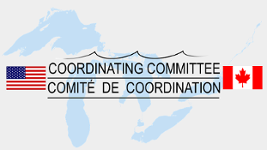The International Great Lakes Datum (IGLD) is periodically updated to account for movements of the Earth’s crust known as glacial isostatic adjustment. The Coordinating Committee currently uses IGLD (1985). This version will be revised and replaced by IGLD (2020) over the next several years.
IGLD (2020) will align with the new geoid-based North American-Pacific Geopotential Datum of 2022 (NAPGD2022). IGLD (2020) is currently scheduled for release sometime after 2026. Please visit the sections below to learn more about activities and topics involved in the IGLD (2020) update.
Seasonal Gauging

Why does the IGLD use seasonal gauges?
Multiple Federal agencies operate their own permanent networks of water level gauges in the Great Lakes region. Seasonal gauges are used to supplement and densify the network of permanent stations used for calculating IGLD heights. The U.S. and Canada spatially align their seasonal gauging to ensure binational consistency across the Great Lakes. To obtain a complete picture of lake topography (due to river discharge, prevailing winds, water temperature variations), U.S. and Canadian Federal agencies will collect water level and Global Navigation Satellite Systems (GNSS) data at about 200 seasonal and permanent ports and harbors of refuge for incorporation into IGLD (2020).
When will IGLD seasonal gauges be installed?
As part of the IGLD (2020) update, field crews will install seasonal water level gauges at close to 100 smaller ports and harbors across the U.S. and Canada to collect data from June to September, during 2017-2023. Bench marks at both seasonal and permanent US and Canadian locations will be included in the Global Navigation Satellite Systems (GNSS) campaign. The GNSS campaign is currently scheduled for Summer 2022.
What is GNSS?
Global Navigation Satellite Systems (GNSS) are constellations of satellites in regular orbit around the earth that are used for positioning purposes. The Global Position System (GPS) is the constellation that the United States operates. Other constellations include GLONASS (Russia), Galileo (European Union), and BeiDou (China). GNSS data is used to support three dimensional positioning, meteorology, and geophysical applications. Surveyors, engineers, scientists, and others use this information to improve the precision of their positions, and align their work within the National Spatial Reference System (NSRS).
GNSS Field Campaign


What is the IGLD GNSS field campaign?
The IGLD Global Navigation Satellite Systems (GNSS) field campaign consists of a group of field survey personnel collecting positioning data from satellite observations by setting up GNSS receivers on specific geodetic control bench marks at specific pre-planned times. The IGLD campaign will have surveyors from multiple agencies of the US and Canadian Governments traveling around the Great Lakes to collect data on approximately 200 bench marks around all of the Great Lakes and connecting channels.
These bench marks were chosen based on their usage in the development of previous IGLD realizations. It is critical that the timing of an international campaign as large as this is performed as planned, as missing data can affect the entire datum development. During the field campaign, and again upon its completion, a team of geodesists will analyze the GNSS data in relation to the American Continuously Operating Reference Stations (CORS) Network (NCN) and Canadian Active Control System (CACS) to develop final data for publication to US and Canadian databases.
When will the IGLD GNSS field campaign take place?
Field survey personnel will be collecting data on control marks at various locations for a period of 1-2 months, in the Summer 2022. These campaigns generally repeat their observations every five years in order to better quantify the impacts of crustal motion related to glacial isostatic adjustment and other motion in the region. Originally planned for 2020, the field campaign was delayed due to travel restrictions.
How are IGLD (2020) and the GNSS field campaign tied to CORS/CACS and NSRS?
Data from the Global Navigation Satellite Systems (GNSS) field campaign will be processed in relationship to the continuous GNSS stations of the NOAA CORS Network and the Canadian Active Control System (CACS), accurately tying the campaign into the National Spatial Reference System (NSRS).
Hydraulic Correctors

Why does the IGLD (1985) use hydraulic correctors?
The water surfaces within each of the Great Lakes are considered geopotentially equal (or equipotential). This would indicate that the dynamic height for mean water level on a particular lake should be the same everywhere. Any deviation from this would be due to errors in the geopotential values developed from the North American Vertical Datum of 1988 (NAVD 88) as well as variations in lake topography (e.g. winds, storm setup, river discharge, hydraulic effects). Hydraulic correctors were used in IGLD (1985) to account for these variations and errors by adjusting the observed water level heights at gauging stations on a lake so they agree with each other over a given time period.
Will existing hydraulic correctors change in the IGLD (2020) update?
Errors in height are expected to be much smaller for a more accurate, geoid-based vertical datum, such as IGLD (2020), resulting in hydraulic correctors that will be both smaller and more representative of actual lake topography than they have been in the past.
 Great Lakes Coordinating Committee
Great Lakes Coordinating Committee